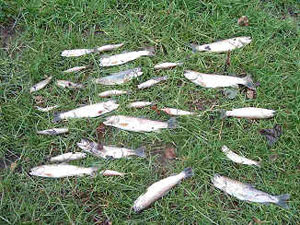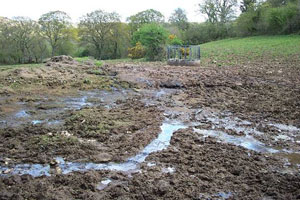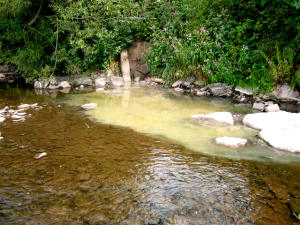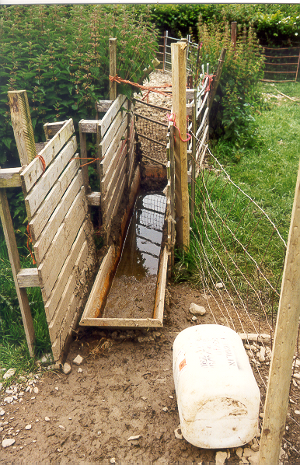Water Pollution



Spot Pollution
(aka 'End of Pipe','Incident' or 'Point Source' pollution)
Over the years, both rivers have suffered serious Spot Pollution events. In 1994, for example, the Wye was badly affected by an accidental discharge of 20 tons of sugar at Hereford. The next year, the River Elan (an Upper Wye tributary) and the Upper Wye itself both received a huge, inadvertent chemical release killing tens of thousands of juvenile fish. This attracted the largest ever fine for pollution in the criminal courts and the compensation recovered enabled the Foundation to commence work restoring the river’s fishery.
Diffuse Pollution
While spot pollution involves a single source, diffuse pollution is a more general malaise which affects the water quality of a river or a whole catchment but is not necessarily traceable to a single point. Examples in the Wye and Usk catchments would include acidification of headwaters, sediments being washed off potato fields into the River Lugg, together with low doses of pesticides and other noxious chemicals, enrichment from sewerage treatment works and aesthetic pollution from litter. It's a cumulative effect. Diffuse pollution is best described as the death by a thousand cuts, rather than from a single wound - as with spot pollution.
Diffuse pollution is often more serious than spot pollution because it is harder to detect and prevent and is often punctuated with more significant incidents. In fact, those responsible are often unaware that they are causing a problem as the impact of their activity alone does not cause any significant damage. Combined, however, it has a disastrous impact on fish and all other wildlife.
Status Today
There have also been numerous incidents of silage, slurry and sheep dip pollution in both our rivers. The Usk once suffered from such poor water quality in the estuary that fish could only migrate in high flows. Thankfully, improvements were made at Newport steelworks and with other discharges. In its lower reaches the river is plagued by diffuse pollution and the occasional release of slurry. This suppresses and occasionally wipes out fish and insect life in vulnerable tributaries such as the Gavenny, Sor and Olway Brooks. The Usk also has a persistent problem with combined sewage overflows (CSOs) at both Brecon and Abergavenny.
In 2008 the Upper Wye was saved from disaster by the prompt action of The Environment Agency and Welsh Water, who were able to combat the threat of damage from a crashed milk lorry that spilled its content into the upper Wye. Extra Elan dam releases were used to dilute the worst effects. The river Trothy, which drains south Monmouthshire and enters the Wye below Monmouth, also suffered serious pollution damage with over 20,000 dead fish reported while upstream at Rhayader, the tiny Rhydhir stream suffered repeated pollution events until the culprit was prosecuted in 2009.
What is the solution to diffuse pollution?
Education: we need to make it absolutely clear to farmers, foresters, gardeners, and builders that causing even small amounts of pollution to water contributes to the death of whole river systems. That's why the Wye & Usk Foundation spends so much time working with people whose actions can have an effect on the condition of the river. Over the last 10 years, we have advised nearly 450 land managers and given presentations to community groups to 1,000s of members. Our fencing and habitat work on the tributaries is designed to reduce the amount of sediment which ends up polluting the whole of the Wye and Usk river systems.
Assistance and Regulation: Some of our project funding (Lugg & River Arrow Project & Water Framework Directive) also allows us to correct such basic farming issues such as clean and dirty water separation but the reality is that different standards are applied between agricultural pollution (lax) and industrial (severe).
The Water Framework Directive and EU law will require government agencies to ensure our SAC water bodies (rivers to most of us) have "good ecological status" by 2015 and the rest by 2027. They should not be allowed to deteriorate under this Directive if sanctions are to be avoided. Diffuse pollution is one of the main reasons why this target is going to require all of us to take action to ensure that we are not contributing to water pollution, even in a small way.
If you ever come across dead fish or anything else that leads you to suspect a pollution event has taken place , ring the Environment Agency immediately on 0800 80 70 60. Also, for guidance on what else you can do, see Fish Legal's website.
Sheep Dip
 Sheep dip pollution requires a special mention, so severe are its effects. In October 1996, the Wye Foundation Habitat Officer visited the Sgithwen brook near Erwood and found large numbers of dead crayfish and invertebrates. Fearing that they were victims of the 'plague' that had destroyed so many elsewhere, he checked above the first waterfall and found the same: all dead along with every invertebrate in the stream.
Sheep dip pollution requires a special mention, so severe are its effects. In October 1996, the Wye Foundation Habitat Officer visited the Sgithwen brook near Erwood and found large numbers of dead crayfish and invertebrates. Fearing that they were victims of the 'plague' that had destroyed so many elsewhere, he checked above the first waterfall and found the same: all dead along with every invertebrate in the stream.
The Environment Agency was contacted and their water samples revealed the presence of small amounts of Synthetic Pyrethroid sheep dip. A prosecution resulted and the Agency conducted a survey of 'at risk' streams in mid and north Wales in 1997 and again in 1998. Much to everyone's surprise and horror, it was Organophosphates that dominated the survey and more than 97% of these streams were affected.
The results of the Environmental Agency Survey in 1998 showed that 16% of farms visited were found to be a high/very high risk of polluting a stream/river. This was an improvement on the 1997 survey, where 26% of the farms surveyed were found to be of high/very high risk. With an average of over 7 holdings per stream this accounts for the very high percentage of pollution.
Recent research has highlighted the dangers to salmonids of the effects of sheep dip even in very low doses and synergistic effects with other agricultural chemicals. It appears that the hatching stages of trout and salmon and the migration phases of salmon are significantly compromised, even with doses below the current acceptable levels – down to one part per trillion. There are also concerns regarding the long term retention of these poisons within stream systems.
Why Dip?
Sheep carry many ectoparasites, including sheep scab, and until recently dipping in chemicals was the best way to treat them. In Wales sheep are often turned out on commons and dipping has been the main line of defence against cross infection. The two main chemicals used are Organophosphates and Synthetic Pyrethroids, both of which are highly toxic to aquatic life. Synthetic Pyetheroid, potentially the more dangerous of the two, has been banned as a legal sheep dip although they are still used elsewhere, such as by the Forestry Commission.
 Sheep dip pollution in rivers occurs for two main reasons. Firstly, the structures used for dipping are often located next to a stream and are frequently in a poor state of repair. Spillages are often accidental although reckless/illegal disposal in streams also occurs, from both permanent and mobile dipping facilities. Secondly, the methods of disposal also contribute – spraying over farmland is a common method despite the fact that Organophosphates can remain in the soil for a very long time. While it is technically possible to neutralise Synthetic Pyrethroids, the amounts left in fleeces pose problems.
Sheep dip pollution in rivers occurs for two main reasons. Firstly, the structures used for dipping are often located next to a stream and are frequently in a poor state of repair. Spillages are often accidental although reckless/illegal disposal in streams also occurs, from both permanent and mobile dipping facilities. Secondly, the methods of disposal also contribute – spraying over farmland is a common method despite the fact that Organophosphates can remain in the soil for a very long time. While it is technically possible to neutralise Synthetic Pyrethroids, the amounts left in fleeces pose problems.
Also of concern:
- There are more than 11,000,000 sheep in Wales.
- Nearly HALF live in the Wye catchment.
- A single adult sheep can hold up to 2 litres of sheep dip after dipping.
- A single recently dipped sheep entering a river could wipe out 11km of river life downstream if SPs used.
- Even a year after dipping, a sheared fleece can still hold a large amount of dip. This could mean that companies processing fleeces are unwittingly adding to the pollution, in other parts of the country.
- Sewage treatment works that receive effluent from live stock markets and fell mongers have been identified as potential sources of sheep dip pollution.
What was done...
"A national strategy for sheep dip must achieve a balance between the requirements of the agricultural industry and the need to protect the environment" (Environment Agency strategic review of Sheep dipping; technical report P170). In addition to in depth water quality monitoring by statutory bodies, fishermen can act as first hand detectives by checking for invertebrate life when visiting the rivers. The Riverfly programme is how this can best be done.
Promoting a code of good practice for disease control in sheep, to include appropriate location and construction of dipping facilities would also help, as would developing and promoting positive flock management to reduce the need to dip and the use of alternative methods. The ban of Synthetic Pyrthroids must continue in all circumstances. The Forestry Commission currently use them to treat young trees and they are also available for non-veterinary purposes.
Finally, the Foundation is promoting river care through its projects and by adding value to streams though the Passport scheme. We saw a need for change in the perception by farmers that water courses are a conduit for litter and waste chemicals.
Click here for more information on sheep dip.
